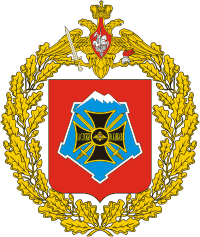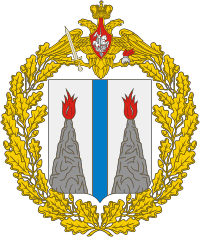
The Western Group of Forces (WGF), previously known as the Group of Soviet Occupation Forces in Germany (GSOFG) and the Group of Soviet Forces in Germany (GSFG), were the troops of the Soviet Army in East Germany. The Group of Soviet Occupation Forces in Germany was formed after the end of World War II in Europe from units of the 1st and 2nd Belorussian Fronts. The group helped suppress the East German uprising of 1953. After the end of occupation functions in 1954 the group was renamed the Group of Soviet Forces in Germany. The group represented Soviet interests in East Germany during the Cold War. Before changes in Soviet foreign policy during the early 1990s, the group shifted to a more offensive role and in 1989 became the Western Group of Forces. Russian forces remained in the eastern part of Germany after the dissolution of the Soviet Union and German reunification until 1994.
The 4th Army was a Soviet field army of World War II that served on the Eastern front of World War II and in the Caucasus during the Cold War. It was disbanded after the fall of the Soviet Union, with its divisions being withdrawn to Russia and disbanded.

The North Caucasus Military District was a military district of the Russian Armed Forces from 1992-2010. Before 1992 it had been part of the Soviet Armed Forces since 1918. In 2010 it became the Southern Military District and lately also included the Black Sea Fleet and Caspian Flotilla.

The Red BannerCarpathian Military District was a military district of the Soviet Armed Forces during the Cold War and subsequently of the Armed Forces of Ukraine during the early Post-Soviet period.

The Far Eastern Military District was a military district of the Armed Forces of the Russian Federation. In 2010 it was merged with the Pacific Fleet and part of the Siberian Military District to form the new Eastern Military District.

The 10th Guards Uralsko-Lvovskaya Volunteer Tank Division, also known as the Ural-Lvov Tank Division, is a tank division of the Russian Ground Forces and part of the Moscow Military District's 20th Guards Army. The division traces its heritage back to 1943, during World War II. It is headquartered and based at Boguchar, 160 kilometres south of Voronezh, Voronezh Oblast.

The Transcaucasian Military District, a military district of the Soviet Armed Forces, traces its history to May 1921 and the incorporation of Armenia, Azerbaijan, and Georgia into the Soviet Union. It was disbanded by being redesignated as a Group of Forces in the early 1990s, after the Soviet Union collapsed. The military district formed as a basis of the modern day armed forces of Armenia, Azerbaijan, and Georgia as well as unrecognized polities of Abkhazia, the Republic of Artsakh and South Ossetia.
The 5th Guards Tank Division was an armored division of the Soviet Ground Forces and Russian Ground Forces, active from 1945 to 2009, in two different formations.

The 51st Guards Mechanized Brigade was a formation of the Ukrainian Ground Forces, stationed at Volodymyr in Volyn Oblast, on the border with Poland. The Brigade drew its history from the 15th Guards Rifle Division of World War II, which was converted into the 15th Guards Motor Rifle Division in 1957. The division was renumbered as the 51st Guards Motor Rifle Division in 1965 and awarded the honorific Perekop in honor of the 51st Rifle Division of the Russian Civil War.

The Transbaikal Military District was a military district of first the Soviet Armed Forces and then the Armed Forces of the Russian Federation, formed on 17 May 1935 and included the Buryat Republic, Chita Oblast, and Yakutia. Chita was the headquarters of the district. It was finally disbanded on 1 December 1998 by being amalgamated with the Siberian Military District, though Chita remained the headquarters of the new amalgamated district.
The 78th Rifle Division was an infantry division of the Red Army, formed in 1932, in Novosibirsk, in the Siberian Military District. After being used to provide cadres for new divisions, in September 1939 the division was reformed for the second time. In 1940 the division was transferred to Khabarovsk in the Far Eastern Front.

The 127th Order of Kutuzov Motor Rifle Division is a division of the Russian Ground Forces. It was reformed from the 59th Separate and 70th Separate Guards Motor Rifle Brigades in 2018, and was the 127th Machine-Gun Artillery Division from 1990 to 2009. The division traces its history to the 66th Rifle Division of World War II.
The 20th Rifle Division was an infantry division of the Soviet Red Army, formed three times. The first formation of the division lasted from 1919 to 1921 and fought during the Russian Civil War before its downsizing into a brigade. The brigade became the 3rd Caucasian Rifle Division, the 3rd Caucasian Mountain Rifle Division, and the 20th Mountain Rifle Division during the interwar years. In 1944 the 20th became the 20th Rifle Division again. It was disbanded after the end of the war. The division briefly reformed between 1955 and 1957 from the 188th Rifle Division and was converted into a motor rifle division.
The 40th Guards Rifle Division was one of a series of ten Guards rifle divisions of the Red Army formed from airborne troops in the spring and summer of 1942 in preparation for, or in response to, the German summer offensive. It fought in the Stalingrad area during that battle, eventually in the operations that encircled German 6th Army, and then continued to serve in the several campaigns in the south sector of the front, helping to liberate Ukraine and the Balkans, and ending the war at Vienna.

The 11th Guards Mechanized Brigade is a unit of the Armed Forces of Belarus based in Slonim. The 11th Guards Brigade traces its history back to the 1942 formation of the 6th Tank Corps of the Soviet Army during World War II.
The 17th Guards Rifle Division was an infantry division of the Red Army during World War II. It was created on March 17, 1942, from the first formation of the 119th Rifle Division, in recognition of that division's stalwart defense against German Army Group Center in the Battle of Moscow, and in the subsequent strategic offensive that threw the German forces back from the capital. It became the 123rd Guards Motor Rifle Division in 1957 and converted into the 129th Guards Machine-Gun Artillery Division in 1989. In 2001, it was converted to the 17th Guards Motor Rifle Division and became the 70th Guards Motor Rifle Brigade in 2009. The brigade was reorganized as the 114th Guards Motor Rifle Regiment of the reformed 127th Motor Rifle Division in 2018. The regiment is currently based in Ussuriysk.
The 180th Rifle Division was an infantry division of the Soviet Red Army, formed thrice.
The 89th Motor Rifle Division was a motor rifle division of the Soviet Army, formed twice. The division was first formed in 1957 from the 14th Mechanized Division, which was the former 284th Rifle Division. In 1966, it was reformed as a mobilization division. In 1987, it became a territorial training center and a storage base soon after. It was disbanded in 1996. The unit was based at Tambov.

The 69th Covering Brigade is a unique border protection brigade of the Russian Ground Forces, stationed at Babstovo, Jewish Autonomous Oblast, and part of the 35th Army. Military Unit в/ч 61424.










